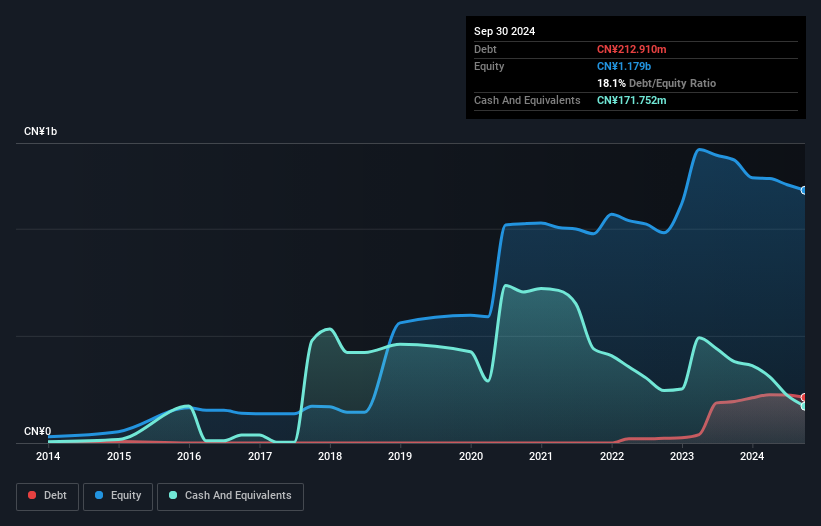Legendary fund manager Li Lu (who Charlie Munger backed) once said, 'The biggest investment risk is not the volatility of prices, but whether you will suffer a permanent loss of capital.' So it seems the smart money knows that debt - which is usually involved in bankruptcies - is a very important factor, when you assess how risky a company is. As with many other companies Tinavi Medical Technologies Co.,Ltd. (SHSE:688277) makes use of debt. But is this debt a concern to shareholders?
When Is Debt Dangerous?
Debt is a tool to help businesses grow, but if a business is incapable of paying off its lenders, then it exists at their mercy. Ultimately, if the company can't fulfill its legal obligations to repay debt, shareholders could walk away with nothing. While that is not too common, we often do see indebted companies permanently diluting shareholders because lenders force them to raise capital at a distressed price. Of course, debt can be an important tool in businesses, particularly capital heavy businesses. When we think about a company's use of debt, we first look at cash and debt together.
How Much Debt Does Tinavi Medical TechnologiesLtd Carry?
You can click the graphic below for the historical numbers, but it shows that as of September 2024 Tinavi Medical TechnologiesLtd had CN¥212.9m of debt, an increase on CN¥193.8m, over one year. However, because it has a cash reserve of CN¥171.8m, its net debt is less, at about CN¥41.2m.

How Healthy Is Tinavi Medical TechnologiesLtd's Balance Sheet?
 Zooming in on the latest balance sheet data, we can see that Tinavi Medical TechnologiesLtd had liabilities of CN¥132.5m due within 12 months and liabilities of CN¥189.8m due beyond that. Offsetting these obligations, it had cash of CN¥171.8m as well as receivables valued at CN¥73.7m due within 12 months. So its liabilities total CN¥76.9m more than the combination of its cash and short-term receivables.
Zooming in on the latest balance sheet data, we can see that Tinavi Medical TechnologiesLtd had liabilities of CN¥132.5m due within 12 months and liabilities of CN¥189.8m due beyond that. Offsetting these obligations, it had cash of CN¥171.8m as well as receivables valued at CN¥73.7m due within 12 months. So its liabilities total CN¥76.9m more than the combination of its cash and short-term receivables.
Having regard to Tinavi Medical TechnologiesLtd's size, it seems that its liquid assets are well balanced with its total liabilities. So it's very unlikely that the CN¥4.98b company is short on cash, but still worth keeping an eye on the balance sheet. Carrying virtually no net debt, Tinavi Medical TechnologiesLtd has a very light debt load indeed. When analysing debt levels, the balance sheet is the obvious place to start. But it is Tinavi Medical TechnologiesLtd's earnings that will influence how the balance sheet holds up in the future. So when considering debt, it's definitely worth looking at the earnings trend. Click here for an interactive snapshot.
In the last year Tinavi Medical TechnologiesLtd had a loss before interest and tax, and actually shrunk its revenue by 18%, to CN¥168m. That's not what we would hope to see.
Caveat Emptor
Not only did Tinavi Medical TechnologiesLtd's revenue slip over the last twelve months, but it also produced negative earnings before interest and tax (EBIT). Indeed, it lost CN¥197m at the EBIT level. Considering that alongside the liabilities mentioned above does not give us much confidence that company should be using so much debt. Quite frankly we think the balance sheet is far from match-fit, although it could be improved with time. However, it doesn't help that it burned through CN¥184m of cash over the last year. So suffice it to say we do consider the stock to be risky. There's no doubt that we learn most about debt from the balance sheet. However, not all investment risk resides within the balance sheet - far from it. Case in point: We've spotted 3 warning signs for Tinavi Medical TechnologiesLtd you should be aware of, and 2 of them are a bit unpleasant.
If you're interested in investing in businesses that can grow profits without the burden of debt, then check out this free list of growing businesses that have net cash on the balance sheet.
Have feedback on this article? Concerned about the content? Get in touch with us directly. Alternatively, email editorial-team (at) simplywallst.com.
This article by Simply Wall St is general in nature. We provide commentary based on historical data and analyst forecasts only using an unbiased methodology and our articles are not intended to be financial advice. It does not constitute a recommendation to buy or sell any stock, and does not take account of your objectives, or your financial situation. We aim to bring you long-term focused analysis driven by fundamental data. Note that our analysis may not factor in the latest price-sensitive company announcements or qualitative material. Simply Wall St has no position in any stocks mentioned.
